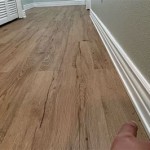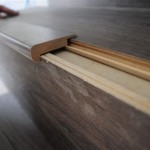What Is Engineered White Oak Flooring?
Engineered white oak flooring is a popular choice for residential and commercial spaces, offering a blend of the aesthetic appeal of solid hardwood with enhanced stability and versatility. Unlike solid white oak flooring, which is made from a single piece of wood, engineered white oak flooring comprises multiple layers bonded together. This construction provides several advantages, making it a practical and often more cost-effective alternative to solid hardwood.
The uppermost layer, known as the wear layer, is a thin slice of genuine white oak. This layer determines the visual characteristics of the floor, showcasing the natural grain patterns, knots, and color variations inherent in white oak. The thickness of this wear layer is a critical factor influencing the durability and longevity of the flooring. A thicker wear layer allows for more sanding and refinishing over the lifespan of the floor, extending its period of use and preserving its appearance.
Beneath the wear layer lies the core, which is typically constructed from multiple layers of plywood or high-density fiberboard (HDF). These layers are arranged in a cross-grain configuration, meaning the grain direction of each layer is perpendicular to the layers above and below it. This cross-grain construction provides exceptional dimensional stability, minimizing the natural tendency of wood to expand and contract with changes in humidity and temperature—a common issue with solid hardwood flooring.
The bottom layer, often referred to as the backing or base layer, provides additional stability and acts as a moisture barrier. This layer helps prevent warping and cupping, ensuring the flooring remains flat and even over time. The type of material used for the backing layer can vary, but it is usually a durable wood product designed to resist moisture penetration.
Key Advantages of Engineered White Oak Flooring
Engineered white oak flooring offers a compelling set of advantages that contribute to its widespread popularity. These advantages stem from its unique construction and the inherent properties of white oak itself.
Dimensional Stability: As previously mentioned, the cross-grain construction of the core layers is a significant benefit. This design significantly reduces the flooring's susceptibility to expansion and contraction caused by fluctuations in humidity and temperature. Solid hardwood, especially wider planks, is prone to cupping, warping, and gapping in environments with significant humidity variations. Engineered flooring, due to its layered construction, resists these issues more effectively. This stability makes it a suitable choice for installation in areas where solid hardwood might not be ideal, such as basements, kitchens, and bathrooms (although proper moisture management is still crucial).
Installation Versatility: Engineered white oak flooring can be installed in a variety of ways, including floating, gluing, or nailing. Floating installations involve connecting the planks together without directly adhering them to the subfloor. This method is relatively simple and quick, making it a popular choice for DIY projects. Glue-down installations provide a more permanent bond to the subfloor, offering enhanced stability and sound reduction. Nail-down installations are similar to those used for solid hardwood and are typically performed by professionals. The versatility in installation methods allows for adaptation to different subfloor types and project requirements.
Cost-Effectiveness: While the initial cost of engineered white oak flooring can vary depending on the wear layer thickness, plank width, and finish, it is generally more affordable than solid white oak flooring. This is primarily due to the more efficient use of white oak wood. The core layers are typically made from less expensive materials, allowing manufacturers to produce a product that retains the beauty and durability of white oak at a lower price point. Furthermore, the easier installation process can also contribute to cost savings, particularly for DIY projects.
Understanding the Wear Layer
The wear layer is the single most important factor in determining the longevity and performance of engineered white oak flooring. Its thickness dictates how many times the floor can be sanded and refinished, directly impacting its lifespan. Thicker wear layers, typically ranging from 3mm to 6mm, offer greater resilience and allow for multiple refinishing cycles. Thinner wear layers, such as those found in some budget-friendly options, may only allow for minimal or no refinishing, limiting the floor's long-term usability.
The quality of the white oak used for the wear layer also significantly impacts the floor's appearance and durability. White oak is known for its hardness and resistance to wear, making it a suitable choice for high-traffic areas. However, the grading of the wood influences the amount of knots, mineral streaks, and color variation present in the wear layer. Select and better grades typically have fewer imperfections and a more uniform appearance, while common grades exhibit a more rustic and character-rich aesthetic. The choice of grade depends on the desired look and the overall design aesthetic of the space.
The wear layer also plays a crucial role in the application of stains and finishes. White oak accepts stains readily, allowing for a wide range of color options to complement various interior design styles. The finish, whether it's a polyurethane, oil-based, or acrylic, protects the wear layer from scratches, dents, and moisture. The type and quality of the finish directly impact the floor's resistance to wear and its ease of maintenance. Durable finishes, such as those with multiple coats and UV protection, provide enhanced protection and extend the floor's lifespan.
Considerations for Choosing Engineered White Oak Flooring
Selecting the right engineered white oak flooring involves careful consideration of several factors to ensure the chosen product meets the specific needs and requirements of the space.
Wear Layer Thickness: As emphasized earlier, the thickness of the wear layer is paramount. Consider the expected traffic level in the area where the flooring will be installed. High-traffic areas, such as hallways and living rooms, benefit from thicker wear layers that can withstand heavy use and allow for future refinishing if necessary. Lower-traffic areas, such as bedrooms, may be suitable for thinner wear layers.
Core Material: The type of material used for the core layers also influences the floor's performance. Plywood cores are generally considered more moisture-resistant and dimensionally stable than HDF cores. However, HDF cores can offer greater density and impact resistance. The choice between the two depends on the specific environmental conditions and the potential for moisture exposure.
Installation Method: Consider the subfloor type and the complexity of the installation process. Floating installations are generally easier for DIY projects, while glue-down or nail-down installations require more expertise and may be best left to professionals. Ensure the subfloor is properly prepared and level before installing the flooring, regardless of the chosen method.
Finish and Texture: The finish and texture of the engineered white oak flooring significantly impact its appearance and feel. Smooth finishes offer a sleek and modern look, while hand-scraped or wire-brushed textures provide a more rustic and traditional aesthetic. The finish should be durable and resistant to scratches and stains, and it should complement the overall design style of the space.
Width and Length of Planks: The width and length of the planks can also affect the overall look and feel of the room. Wider planks can create a more spacious and luxurious feel, while narrower planks can provide a more traditional and classic appearance. Longer planks can minimize the number of seams in the floor, creating a cleaner and more cohesive look. Carefully consider the dimensions of the room and the desired aesthetic when selecting the plank width and length.
In summary, engineered white oak flooring presents a compelling option for homeowners and designers seeking the beauty and durability of hardwood with enhanced stability and versatility. By understanding its construction, advantages, and key considerations, informed decisions can be made to select the right product and ensure a long-lasting and beautiful floor.

White Oak Hardwood Flooring The Engineered Planks

White Oak Engineered Wood Flooring

White Oak Engineered Prefinished Stained Na

Engineered White Oak 5 Inch 15 Mm 4 Real Wood Brushed Aria Vici

Shaw Repel Reflections White Oak Engineered Hardwood Flooring Natural 7 Greenflooringsupply Com

Superior White Oak Engineered Almond Smooth 5 3 16 X 4 Matte Sh

White Oak Engineered Hardwood Floors Kate Knowles Home

Natural Engineered Flooring Oak Double White Brushed Uv Lacquered 14 3mm By 150mm 400 1500mm At Wood And Beyond

Berkeley White Oak

Bungalow Brushed Light White Oak Engineered Hardwood
Related Posts








